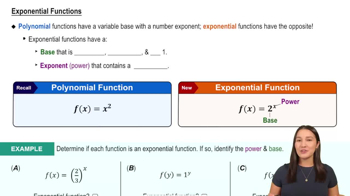Table of contents
- 0. Functions7h 52m
- Introduction to Functions16m
- Piecewise Functions10m
- Properties of Functions9m
- Common Functions1h 8m
- Transformations5m
- Combining Functions27m
- Exponent rules32m
- Exponential Functions28m
- Logarithmic Functions24m
- Properties of Logarithms34m
- Exponential & Logarithmic Equations35m
- Introduction to Trigonometric Functions38m
- Graphs of Trigonometric Functions44m
- Trigonometric Identities47m
- Inverse Trigonometric Functions48m
- 1. Limits and Continuity2h 2m
- 2. Intro to Derivatives1h 33m
- 3. Techniques of Differentiation3h 18m
- 4. Applications of Derivatives2h 38m
- 5. Graphical Applications of Derivatives6h 2m
- 6. Derivatives of Inverse, Exponential, & Logarithmic Functions2h 37m
- 7. Antiderivatives & Indefinite Integrals1h 26m
- 8. Definite Integrals4h 44m
- 9. Graphical Applications of Integrals2h 27m
- 10. Physics Applications of Integrals 2h 22m
2. Intro to Derivatives
Derivatives as Functions
Problem 3.96c
Textbook Question
Computing the derivative of f(x) = e^-x
c. Use parts (a) and (b) to find the derivative of f(x) = e^-x.
 Verified step by step guidance
Verified step by step guidance1
Step 1: Recall the derivative of the exponential function. The derivative of \( e^x \) with respect to \( x \) is \( e^x \).
Step 2: Apply the chain rule for differentiation. The chain rule states that if you have a composite function \( f(g(x)) \), its derivative is \( f'(g(x)) \cdot g'(x) \).
Step 3: Identify the inner function \( g(x) = -x \) and the outer function \( f(u) = e^u \) where \( u = g(x) \).
Step 4: Differentiate the inner function \( g(x) = -x \). The derivative \( g'(x) \) is \( -1 \).
Step 5: Combine the results using the chain rule. The derivative of \( f(x) = e^{-x} \) is \( e^{-x} \cdot (-1) \).
 Verified video answer for a similar problem:
Verified video answer for a similar problem:This video solution was recommended by our tutors as helpful for the problem above
Video duration:
5mPlay a video:
Was this helpful?
Key Concepts
Here are the essential concepts you must grasp in order to answer the question correctly.
Derivative
The derivative of a function measures how the function's output value changes as its input value changes. It is defined as the limit of the average rate of change of the function over an interval as the interval approaches zero. In calculus, the derivative is often denoted as f'(x) or df/dx, and it provides critical information about the function's behavior, such as its slope and points of tangency.
Recommended video:

Derivatives
Exponential Functions
Exponential functions are mathematical functions of the form f(x) = a * e^(bx), where 'e' is the base of natural logarithms, approximately equal to 2.71828. The function f(x) = e^-x is a specific case where the base 'e' is raised to the power of a negative variable, resulting in a function that decreases rapidly as x increases. Understanding the properties of exponential functions is essential for computing their derivatives.
Recommended video:

Exponential Functions
Chain Rule
The chain rule is a fundamental technique in calculus used to differentiate composite functions. It states that if a function y = f(g(x)) is composed of two functions, the derivative can be found by multiplying the derivative of the outer function f with the derivative of the inner function g. This rule is particularly useful when dealing with functions like e^-x, where the exponent itself is a function of x.
Recommended video:

Intro to the Chain Rule
Related Videos
Related Practice



